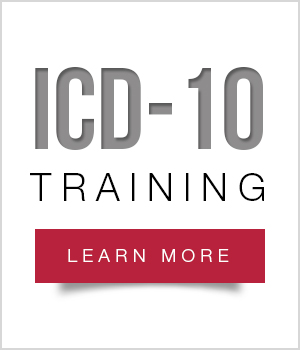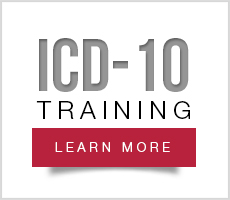When is the ICD-10 compliance deadline?
The ICD-10 deadline is October 1, 2015.
What does ICD-10 compliance mean?
ICD-10 compliance means that a HIPAA-covered entity uses ICD-10 codes for health care services provided on or after October 1, 2015. ICD-9 diagnosis and inpatient procedure codes cannot be used for services provided on or after this date. Everyone covered by HIPAA must be ICD-10 compliant starting on October 1, 2015.
Will ICD-10 replace Current Procedural Terminology (CPT) coding?
No. The transition to ICD-10 does not affect CPT coding for outpatient procedures and physician services. Like ICD-9 procedure codes, ICD-10-PCS codes are for hospital inpatient procedures only.
Who is affected by the transition to ICD-10? If I don’t deal with Medicare claims, will I have to transition?
Everyone covered by HIPAA must use ICD-10 starting October 1, 2015. This includes home health agencies and payers who do not deal with Medicare claims. Organizations that are not covered by HIPAA, but use ICD-9 codes should be aware that their coding may become obsolete if they do not transition to ICD-10.
Do state Medicaid programs need to transition to ICD-10?
Yes. Like everyone else covered by HIPAA, state Medicaid programs must use ICD-10 for services provided on or after October 1, 2015.
What happens if I don’t switch to ICD-10?
Claims for all health care procedures performed on or after October 1, 2015, must use ICD-10 diagnosis and inpatient procedure codes. (This does not apply to CPT coding for outpatient procedures.) Claims that do not use ICD-10 diagnosis and inpatient procedure codes cannot be processed. It is important to note, however, that claims for services provided before October 1, 2015, must use ICD-9 diagnosis and inpatient procedure codes.
Will I need to use both ICD-9 and ICD-10 codes during the transition?
Practice management systems must be able to accommodate both ICD-9 and ICD-10 codes until all claims and other transactions for services before October 1, 2015, have been processed and completed. Promptly processing ICD-9 transactions as the transition date nears will help limit disruptions and will limit the timeframe when dual code sets need to be used.
If I transition early to ICD-10, will CMS be able to process my claims?
No. CMS and other payers will not be able to process claims using ICD-10 until the October 1, 2015, compliance date. However, organizations will need to work with their internal team and with business trading partners to test their software systems from beginning to end. This involves testing claims, eligibility verification, quality reporting and other transactions and processes using ICD-10 to make sure the new code set can be processed correctly.
Codes change every year, so why is the transition to ICD-10 any different from the annual code changes?
ICD-10 codes are completely different from ICD-9 codes. Currently, ICD-9 codes are mostly numeric and have 3 to 5 digits. ICD-10 codes are alphanumeric and contain 3 to 7 characters. ICD-10 is more robust and descriptive with “one-to-many” matches to ICD-9 in some instances. Like ICD-9 codes are now, ICD-10 codes will be updated every year. ICD-9 codes will not continue to be updated after October 1, 2015.
Why is the switch to ICD-10 happening?
The health care industry is making the transition from ICD-9 to ICD-10 because:
- ICD-9 codes provide limited data about patients’ medical conditions and hospital inpatient procedures. ICD-9 is 30 years old, it has outdated and obsolete terms, and is inconsistent with current medical practices. Also, the structure of ICD-9 limits the number of new codes that can be created, and many ICD-9 categories are full.
- ICD-10 codes allow for greater specificity and exactness in describing a patient’s diagnosis and in classifying inpatient procedures. ICD-10 will also accommodate newly developed diagnoses and procedures, innovations in technology and treatment, performance-based payment systems, and more accurate billing. ICD-10 coding will make the billing process more streamlined and efficient, and this will also allow for more precise methods of detecting fraud.
What should home health agencies do to prepare for the transition to ICD-10?
For home health agencies who have not yet started to transition to ICD-10, below are action steps to take now. Some of these activities, such as establishing a transition team and communicating to internal staff, might not be necessary for small home health agencies where one or two people would be handling the transition activities.
- Establish a transition team or ICD-10 project coordinator, depending on the size of your agency, to lead the transition to ICD-10 for your agency.
- Develop a plan for making the transition to ICD-10; include a timeline that identifies tasks to be completed and crucial milestones/relationships, task owners, resources needed, and estimated start and end dates.
- Determine how ICD-10 will affect your agency. Start by reviewing how and where you currently use ICD-9 codes. Make sure you have accounted for the use of ICD-9 in authorizations/pre-certifications, physician orders, medical records, superbills/encounter forms, practice management and billing systems, and coding manuals.
- Review how ICD-10 will affect clinical documentation requirements and electronic health record(EHR) templates.
- Communicate the plan, timeline, and new system changes and processes to your agency, and ensure that leadership and staff understand the extent of the effort the ICD-10 transition requires.
- Secure a budget that accounts for software upgrades/software license costs, hardware procurement, staff training costs, revision of forms, work flow changes during and after implementation, and risk mitigation.
- Talk with your payers, billing and IT staff, and practice management system and/or EHR vendors about their preparations and readiness.
- Coordinate your ICD-10 transition plans among your trading partners and evaluate contracts with payers and vendors for policy revisions, testing timelines, and costs related to the ICD-10 transition.
- Talk to your trading partners about testing, and create a testing plan.
What do home health agencies need to do to make sure their ICD-10 systems are working properly?
Agencies should plan to test their ICD-10 systems early to help ensure they will be ready by the compliance date. Plan to test claims, eligibility verification, quality reporting, and other transactions and processes that involve ICD-10 codes from beginning to end. It is important to test both within your agency and with your payers and other business partners.
Beginning steps in the testing phase include:
- Working with practice management system and/or EHR vendors/IT staff and coders/billers to develop and test processes and systems using ICD-10 codes
- Determining when you will be ready to test, and working with payers and any clearinghouses or billing services that you use to schedule testing
- Developing a testing plan that outlines key dates and milestones for when tests should be completed
What steps can I take to ensure my practice has a smooth transition to ICD-10?
The following are steps you can take to ensure a smooth transition to ICD-10:
- Have a transition plan in place and make sure it documents the steps being followed and the dates that milestones will be achieved to comply with ICD-10 requirements
- Include vendor tasks in your plan and timeline, and make sure to communicate with your practice management system and/or EHR vendors regularly about ICD-10
- Establish an emergency fund to cover unexpected costs and possible reimbursement delays
What should payers do to prepare for the transition to ICD-10?
The transition to ICD-10 involves new coding rules, so it will be important for payers to review payment and benefit policies. Payers should ask software vendors about their readiness plans and timelines for product development, testing, availability, and training. Also ask billing services and clearinghouses, as well as the providers you work with, what they are doing to prepare and what their timelines are for testing and implementation. In order to upgrade to ICD-10 successfully, it is important to coordinate with business trading partners and test processes and transactions that use ICD-10 codes from beginning to end. It also is important to review and evaluate trading partner agreements and contracts.
What should software vendors, clearinghouses, and third-party billing services be doing to prepare their customers for the transition to ICD-10?
Software vendors should be working with customers to install and test ICD-10-ready products. Take a proactive role in assisting with the transition and partner with your customers so that they can get their claim spaid and avoid any interruption to their business processes. Products and services will be obsolete if steps are not taken to prepare.Clearinghouses and third-party billing services should be coordinating with vendors to ensure software products are up-to-date, and should be ready to test claims and other transactions using ICD-10 with home health agencies and payers. Please note, clearinghouse services do not convert ICD-9 to ICD-10 for home health agencies and payers.
Why should I prepare now for the ICD-10 transition?
The transition from ICD-9 to ICD-10 will change how you do business. Home health agencies, from large, medium to small will need to devote staff time and financial resources for transition activities.
What type of training will providers and staff need for the ICD-10 transition?
The American Health Information Management Association (AHIMA) recommends training begin no more than six to nine months before the October 1, 2015, compliance deadline. It is projected to take 1 hours for outpatient coders and 50 hours for inpatient coders. Home health coders are projected to require 24 - 40 hours of focused training. Coders in physician practices will need to learn ICD-10 diagnosis coding only, while hospital coders will need to learn both ICD-10 diagnosis and ICD-10 inpatient procedure coding. Take into account that ICD-10 coding training may be integrated into the CEs that certified coders must take to maintain their credentials. In addition, some high-level ICD-10 training will be required earlier so that staff can conduct testing in 2013. This includes training to learn the new ICD-10 systems and understand how the structure and granularity of the ICD-10 codes will affect clinical documentation.
Where can I find training opportunities?
Axxess provides comprehensive educational seminars that will aid in your transition process. Continuing medical education credits are available to attendees. Learn More.



